check engine CADILLAC SRX 2009 1.G Owner's Guide
[x] Cancel search | Manufacturer: CADILLAC, Model Year: 2009, Model line: SRX, Model: CADILLAC SRX 2009 1.GPages: 442, PDF Size: 2.42 MB
Page 303 of 442
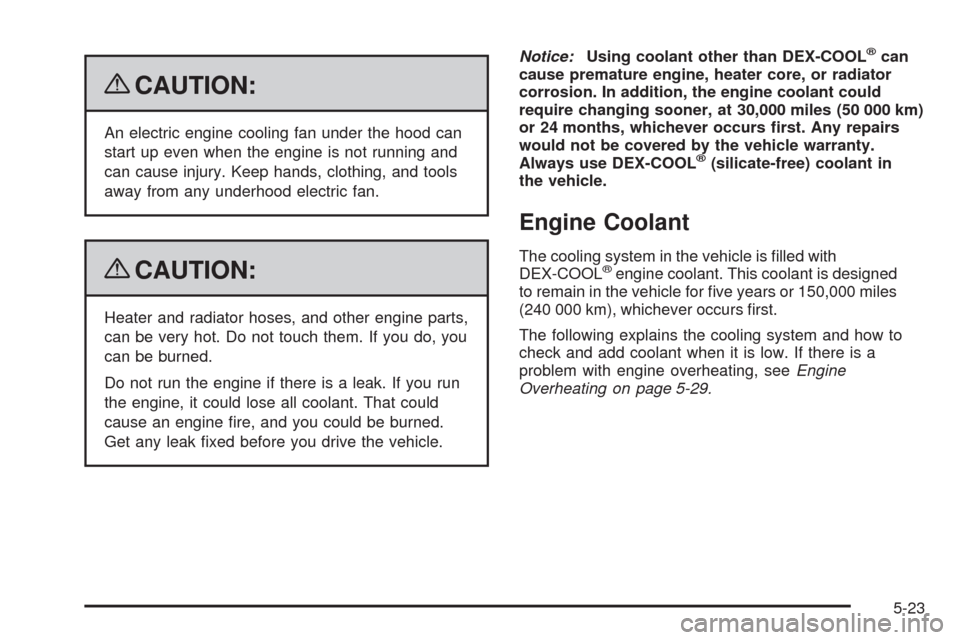
{CAUTION:
An electric engine cooling fan under the hood can
start up even when the engine is not running and
can cause injury. Keep hands, clothing, and tools
away from any underhood electric fan.
{CAUTION:
Heater and radiator hoses, and other engine parts,
can be very hot. Do not touch them. If you do, you
can be burned.
Do not run the engine if there is a leak. If you run
the engine, it could lose all coolant. That could
cause an engine �re, and you could be burned.
Get any leak �xed before you drive the vehicle.Notice:Using coolant other than DEX-COOL
®can
cause premature engine, heater core, or radiator
corrosion. In addition, the engine coolant could
require changing sooner, at 30,000 miles (50 000 km)
or 24 months, whichever occurs �rst. Any repairs
would not be covered by the vehicle warranty.
Always use DEX-COOL
®(silicate-free) coolant in
the vehicle.
Engine Coolant
The cooling system in the vehicle is �lled with
DEX-COOL®engine coolant. This coolant is designed
to remain in the vehicle for �ve years or 150,000 miles
(240 000 km), whichever occurs �rst.
The following explains the cooling system and how to
check and add coolant when it is low. If there is a
problem with engine overheating, seeEngine
Overheating on page 5-29.
5-23
Page 305 of 442
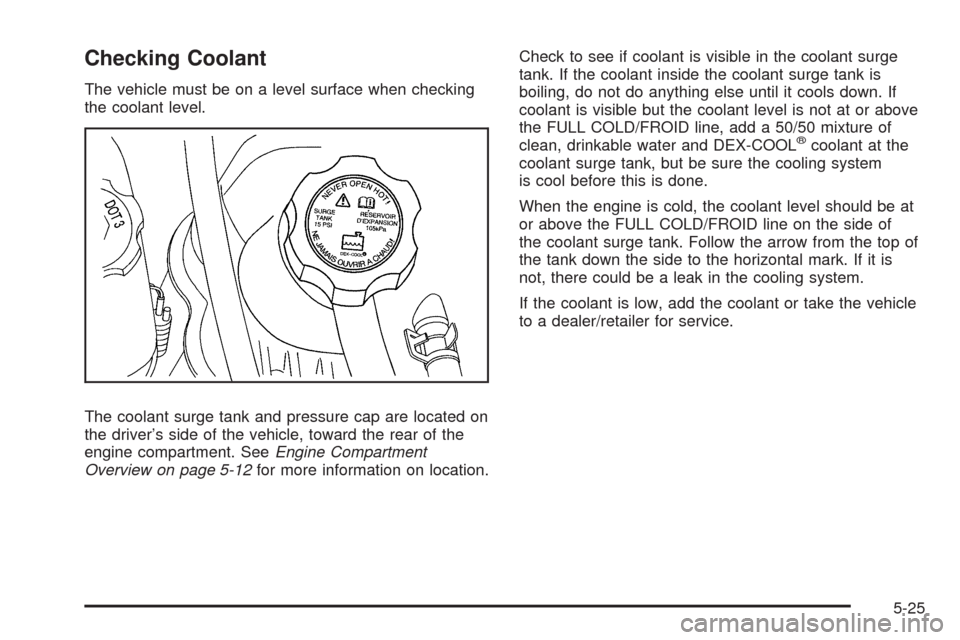
Checking Coolant
The vehicle must be on a level surface when checking
the coolant level.
The coolant surge tank and pressure cap are located on
the driver’s side of the vehicle, toward the rear of the
engine compartment. SeeEngine Compartment
Overview on page 5-12for more information on location.Check to see if coolant is visible in the coolant surge
tank. If the coolant inside the coolant surge tank is
boiling, do not do anything else until it cools down. If
coolant is visible but the coolant level is not at or above
the FULL COLD/FROID line, add a 50/50 mixture of
clean, drinkable water and DEX-COOL
®coolant at the
coolant surge tank, but be sure the cooling system
is cool before this is done.
When the engine is cold, the coolant level should be at
or above the FULL COLD/FROID line on the side of
the coolant surge tank. Follow the arrow from the top of
the tank down the side to the horizontal mark. If it is
not, there could be a leak in the cooling system.
If the coolant is low, add the coolant or take the vehicle
to a dealer/retailer for service.
5-25
Page 309 of 442
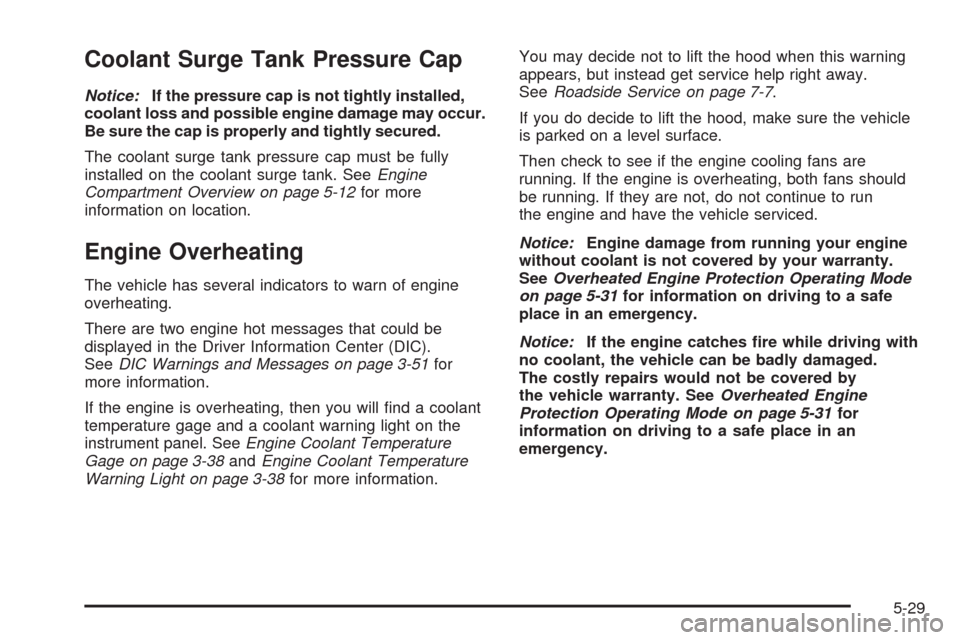
Coolant Surge Tank Pressure Cap
Notice:If the pressure cap is not tightly installed,
coolant loss and possible engine damage may occur.
Be sure the cap is properly and tightly secured.
The coolant surge tank pressure cap must be fully
installed on the coolant surge tank. SeeEngine
Compartment Overview on page 5-12for more
information on location.
Engine Overheating
The vehicle has several indicators to warn of engine
overheating.
There are two engine hot messages that could be
displayed in the Driver Information Center (DIC).
SeeDIC Warnings and Messages on page 3-51for
more information.
If the engine is overheating, then you will �nd a coolant
temperature gage and a coolant warning light on the
instrument panel. SeeEngine Coolant Temperature
Gage on page 3-38andEngine Coolant Temperature
Warning Light on page 3-38for more information.You may decide not to lift the hood when this warning
appears, but instead get service help right away.
SeeRoadside Service on page 7-7.
If you do decide to lift the hood, make sure the vehicle
is parked on a level surface.
Then check to see if the engine cooling fans are
running. If the engine is overheating, both fans should
be running. If they are not, do not continue to run
the engine and have the vehicle serviced.
Notice:Engine damage from running your engine
without coolant is not covered by your warranty.
SeeOverheated Engine Protection Operating Mode
on page 5-31for information on driving to a safe
place in an emergency.
Notice:If the engine catches �re while driving with
no coolant, the vehicle can be badly damaged.
The costly repairs would not be covered by
the vehicle warranty. SeeOverheated Engine
Protection Operating Mode on page 5-31for
information on driving to a safe place in an
emergency.
5-29
Page 311 of 442
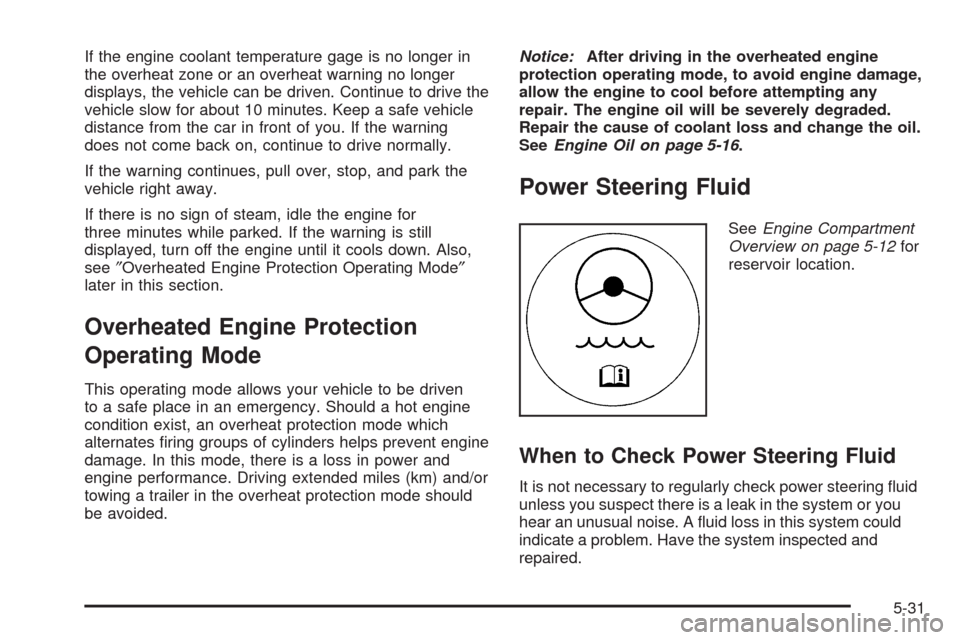
If the engine coolant temperature gage is no longer in
the overheat zone or an overheat warning no longer
displays, the vehicle can be driven. Continue to drive the
vehicle slow for about 10 minutes. Keep a safe vehicle
distance from the car in front of you. If the warning
does not come back on, continue to drive normally.
If the warning continues, pull over, stop, and park the
vehicle right away.
If there is no sign of steam, idle the engine for
three minutes while parked. If the warning is still
displayed, turn off the engine until it cools down. Also,
see″Overheated Engine Protection Operating Mode″
later in this section.
Overheated Engine Protection
Operating Mode
This operating mode allows your vehicle to be driven
to a safe place in an emergency. Should a hot engine
condition exist, an overheat protection mode which
alternates �ring groups of cylinders helps prevent engine
damage. In this mode, there is a loss in power and
engine performance. Driving extended miles (km) and/or
towing a trailer in the overheat protection mode should
be avoided.Notice:After driving in the overheated engine
protection operating mode, to avoid engine damage,
allow the engine to cool before attempting any
repair. The engine oil will be severely degraded.
Repair the cause of coolant loss and change the oil.
SeeEngine Oil on page 5-16.
Power Steering Fluid
SeeEngine Compartment
Overview on page 5-12for
reservoir location.
When to Check Power Steering Fluid
It is not necessary to regularly check power steering �uid
unless you suspect there is a leak in the system or you
hear an unusual noise. A �uid loss in this system could
indicate a problem. Have the system inspected and
repaired.
5-31
Page 312 of 442
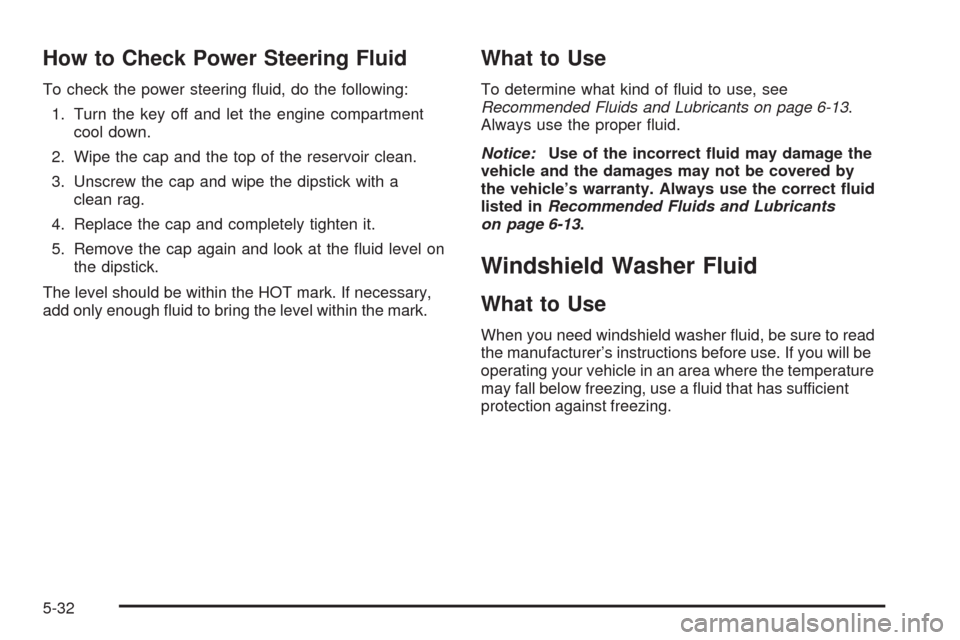
How to Check Power Steering Fluid
To check the power steering �uid, do the following:
1. Turn the key off and let the engine compartment
cool down.
2. Wipe the cap and the top of the reservoir clean.
3. Unscrew the cap and wipe the dipstick with a
clean rag.
4. Replace the cap and completely tighten it.
5. Remove the cap again and look at the �uid level on
the dipstick.
The level should be within the HOT mark. If necessary,
add only enough �uid to bring the level within the mark.
What to Use
To determine what kind of �uid to use, see
Recommended Fluids and Lubricants on page 6-13.
Always use the proper �uid.
Notice:Use of the incorrect �uid may damage the
vehicle and the damages may not be covered by
the vehicle’s warranty. Always use the correct �uid
listed inRecommended Fluids and Lubricants
on page 6-13.
Windshield Washer Fluid
What to Use
When you need windshield washer �uid, be sure to read
the manufacturer’s instructions before use. If you will be
operating your vehicle in an area where the temperature
may fall below freezing, use a �uid that has sufficient
protection against freezing.
5-32
Page 314 of 442
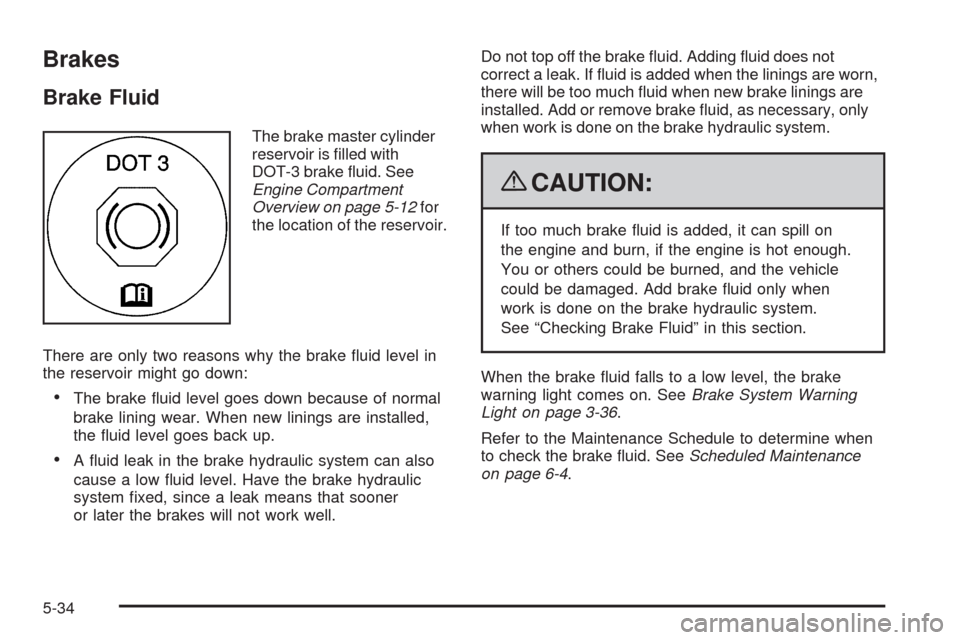
Brakes
Brake Fluid
The brake master cylinder
reservoir is �lled with
DOT-3 brake �uid. See
Engine Compartment
Overview on page 5-12for
the location of the reservoir.
There are only two reasons why the brake �uid level in
the reservoir might go down:
The brake �uid level goes down because of normal
brake lining wear. When new linings are installed,
the �uid level goes back up.
A �uid leak in the brake hydraulic system can also
cause a low �uid level. Have the brake hydraulic
system �xed, since a leak means that sooner
or later the brakes will not work well.Do not top off the brake �uid. Adding �uid does not
correct a leak. If �uid is added when the linings are worn,
there will be too much �uid when new brake linings are
installed. Add or remove brake �uid, as necessary, only
when work is done on the brake hydraulic system.
{CAUTION:
If too much brake �uid is added, it can spill on
the engine and burn, if the engine is hot enough.
You or others could be burned, and the vehicle
could be damaged. Add brake �uid only when
work is done on the brake hydraulic system.
See “Checking Brake Fluid” in this section.
When the brake �uid falls to a low level, the brake
warning light comes on. SeeBrake System Warning
Light on page 3-36.
Refer to the Maintenance Schedule to determine when
to check the brake �uid. SeeScheduled Maintenance
on page 6-4.
5-34
Page 315 of 442
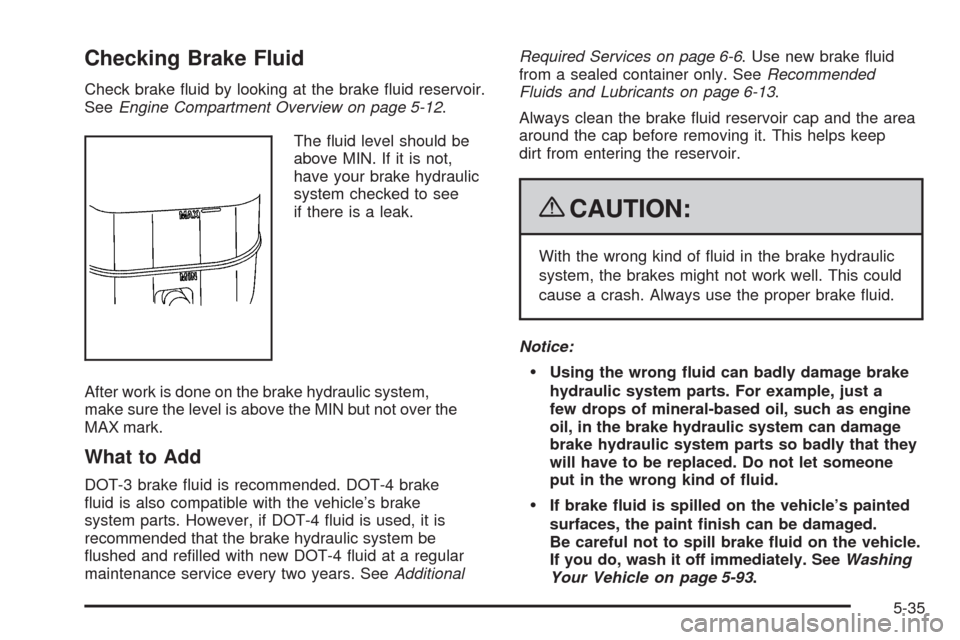
Checking Brake Fluid
Check brake �uid by looking at the brake �uid reservoir.
SeeEngine Compartment Overview on page 5-12.
The �uid level should be
above MIN. If it is not,
have your brake hydraulic
system checked to see
if there is a leak.
After work is done on the brake hydraulic system,
make sure the level is above the MIN but not over the
MAX mark.
What to Add
DOT-3 brake �uid is recommended. DOT-4 brake
�uid is also compatible with the vehicle’s brake
system parts. However, if DOT-4 �uid is used, it is
recommended that the brake hydraulic system be
�ushed and re�lled with new DOT-4 �uid at a regular
maintenance service every two years. SeeAdditionalRequired Services on page 6-6. Use new brake �uid
from a sealed container only. SeeRecommended
Fluids and Lubricants on page 6-13.
Always clean the brake �uid reservoir cap and the area
around the cap before removing it. This helps keep
dirt from entering the reservoir.
{CAUTION:
With the wrong kind of �uid in the brake hydraulic
system, the brakes might not work well. This could
cause a crash. Always use the proper brake �uid.
Notice:
Using the wrong �uid can badly damage brake
hydraulic system parts. For example, just a
few drops of mineral-based oil, such as engine
oil, in the brake hydraulic system can damage
brake hydraulic system parts so badly that they
will have to be replaced. Do not let someone
put in the wrong kind of �uid.
If brake �uid is spilled on the vehicle’s painted
surfaces, the paint �nish can be damaged.
Be careful not to spill brake �uid on the vehicle.
If you do, wash it off immediately. SeeWashing
Your Vehicle on page 5-93.
5-35
Page 320 of 442
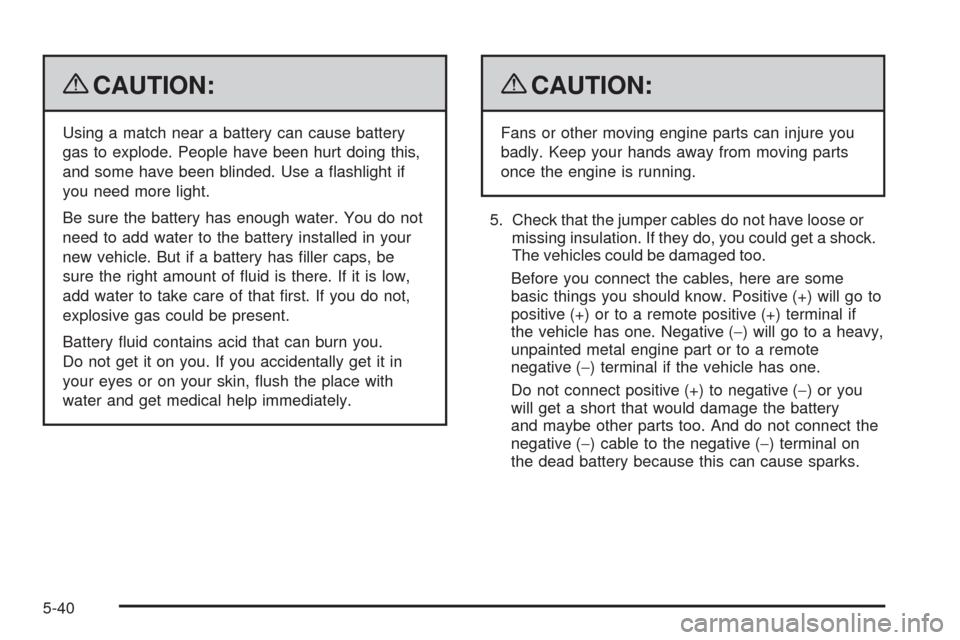
{CAUTION:
Using a match near a battery can cause battery
gas to explode. People have been hurt doing this,
and some have been blinded. Use a �ashlight if
you need more light.
Be sure the battery has enough water. You do not
need to add water to the battery installed in your
new vehicle. But if a battery has �ller caps, be
sure the right amount of �uid is there. If it is low,
add water to take care of that �rst. If you do not,
explosive gas could be present.
Battery �uid contains acid that can burn you.
Do not get it on you. If you accidentally get it in
your eyes or on your skin, �ush the place with
water and get medical help immediately.
{CAUTION:
Fans or other moving engine parts can injure you
badly. Keep your hands away from moving parts
once the engine is running.
5. Check that the jumper cables do not have loose or
missing insulation. If they do, you could get a shock.
The vehicles could be damaged too.
Before you connect the cables, here are some
basic things you should know. Positive (+) will go to
positive (+) or to a remote positive (+) terminal if
the vehicle has one. Negative (−) will go to a heavy,
unpainted metal engine part or to a remote
negative (−) terminal if the vehicle has one.
Do not connect positive (+) to negative (−)oryou
will get a short that would damage the battery
and maybe other parts too. And do not connect the
negative (−) cable to the negative (−) terminal on
the dead battery because this can cause sparks.
5-40
Page 322 of 442
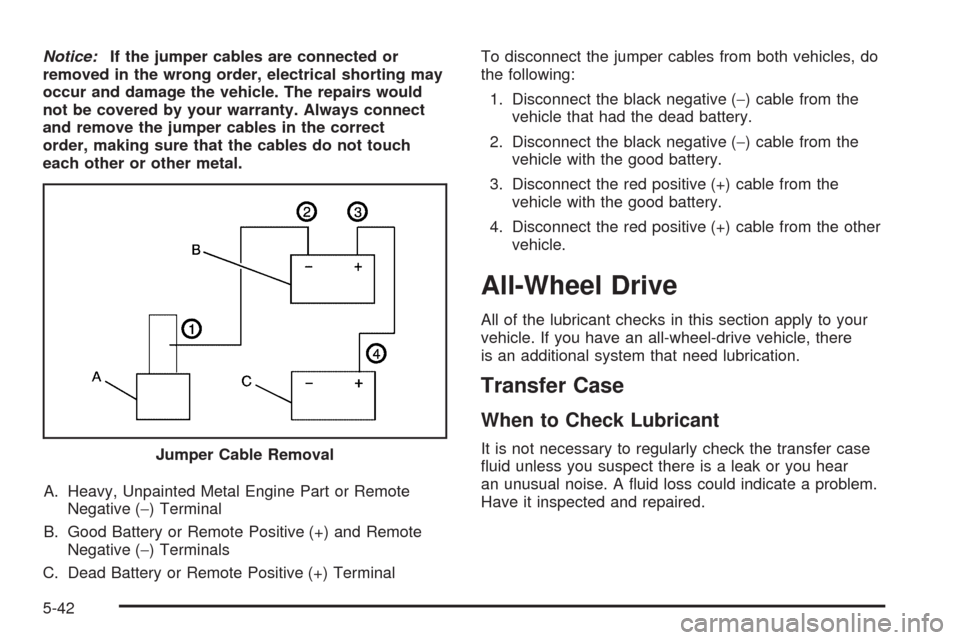
Notice:If the jumper cables are connected or
removed in the wrong order, electrical shorting may
occur and damage the vehicle. The repairs would
not be covered by your warranty. Always connect
and remove the jumper cables in the correct
order, making sure that the cables do not touch
each other or other metal.
A. Heavy, Unpainted Metal Engine Part or Remote
Negative (−) Terminal
B. Good Battery or Remote Positive (+) and Remote
Negative (−) Terminals
C. Dead Battery or Remote Positive (+) TerminalTo disconnect the jumper cables from both vehicles, do
the following:
1. Disconnect the black negative (−) cable from the
vehicle that had the dead battery.
2. Disconnect the black negative (−) cable from the
vehicle with the good battery.
3. Disconnect the red positive (+) cable from the
vehicle with the good battery.
4. Disconnect the red positive (+) cable from the other
vehicle.
All-Wheel Drive
All of the lubricant checks in this section apply to your
vehicle. If you have an all-wheel-drive vehicle, there
is an additional system that need lubrication.
Transfer Case
When to Check Lubricant
It is not necessary to regularly check the transfer case
�uid unless you suspect there is a leak or you hear
an unusual noise. A �uid loss could indicate a problem.
Have it inspected and repaired. Jumper Cable Removal
5-42
Page 390 of 442
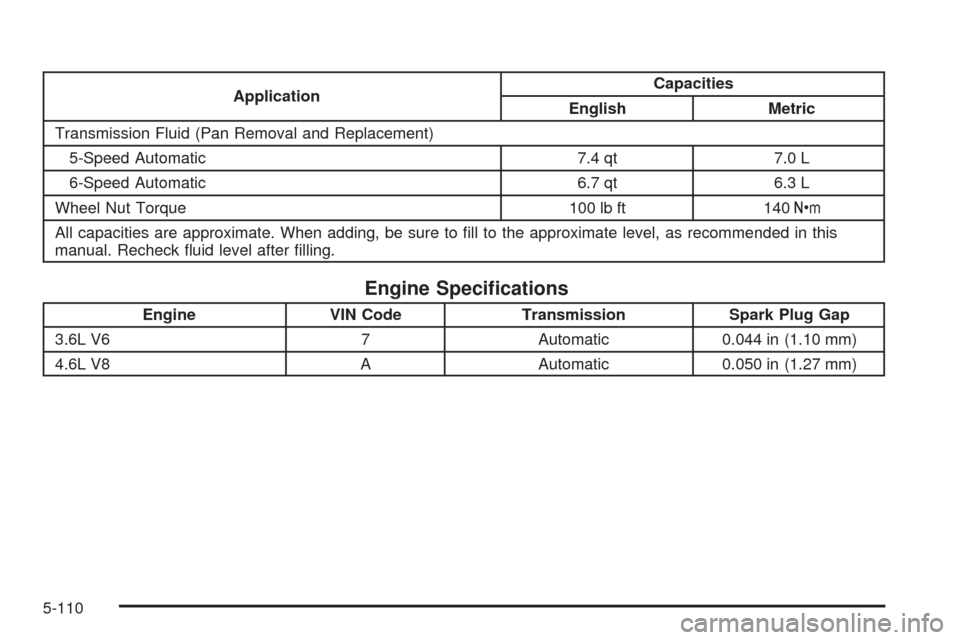
ApplicationCapacities
English Metric
Transmission Fluid (Pan Removal and Replacement)
5-Speed Automatic 7.4 qt 7.0 L
6-Speed Automatic 6.7 qt 6.3 L
Wheel Nut Torque 100 lb ft 140Y
All capacities are approximate. When adding, be sure to �ll to the approximate level, as recommended in this
manual. Recheck �uid level after �lling.
Engine Speci�cations
Engine VIN Code Transmission Spark Plug Gap
3.6L V6 7 Automatic 0.044 in (1.10 mm)
4.6L V8 A Automatic 0.050 in (1.27 mm)
5-110